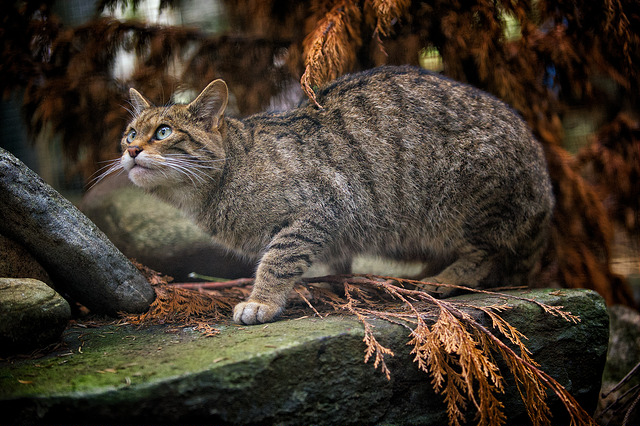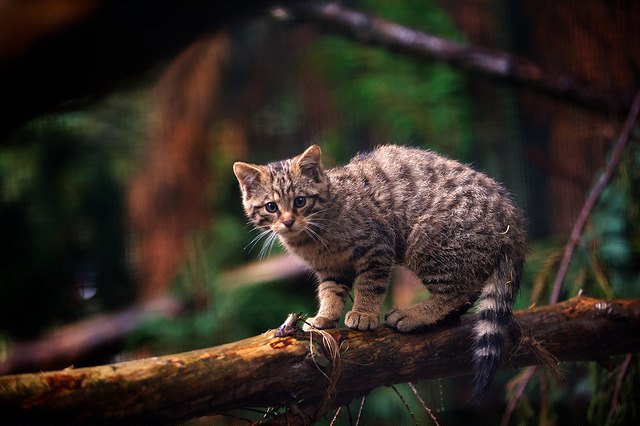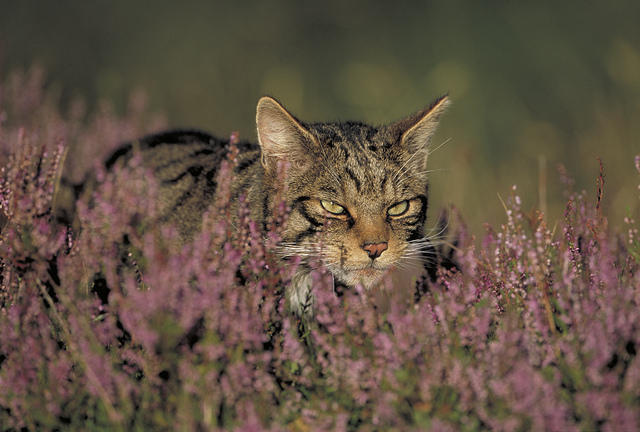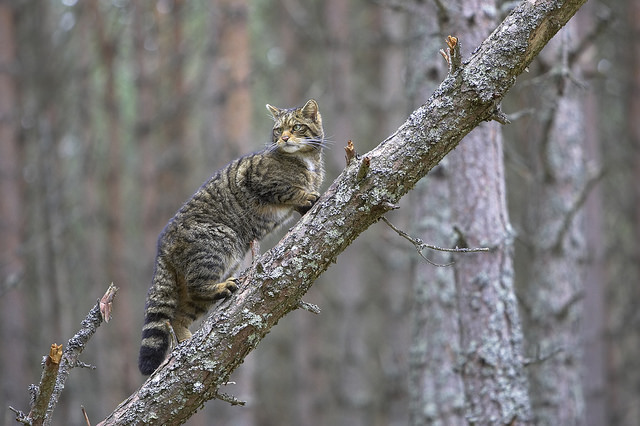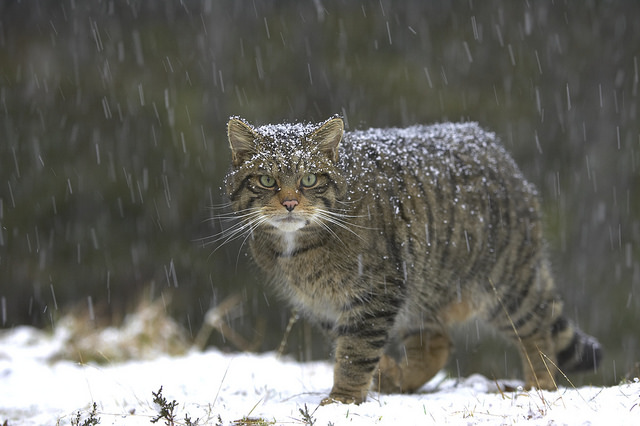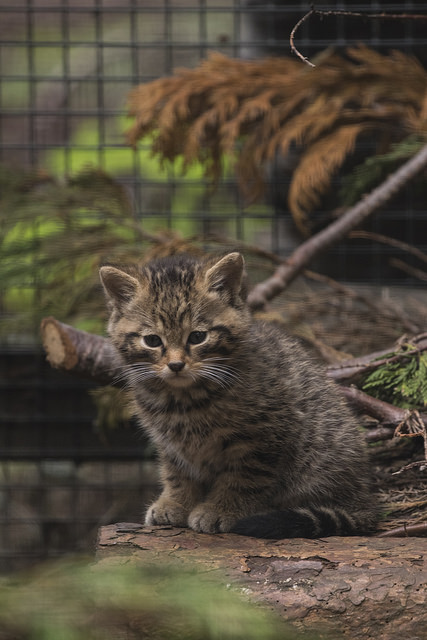Wildcats Everywhere!
Nina Seale investigates the campaign to save the Scottish Wildcat. Illustration by Molly Soar.
Consider the pet cat. This may bring to mind internet sensations like Maru the Youtube star (who adores throwing himself into too-small boxes) or Taylor Swift’s Insta-moggie Meredith. Or maybe you are thinking of your own cat, with its changeable temperament, fear of water, and habit of climbing into your chest of drawers. Like us, these cats have become adapted to their domestic life. They hate rain, stay inside on cold nights and prefer their food pre-killed and served in a dish (preferably on a higher platform than that slobbery ruffian, the dog).
These cats are the descendants of the North African wildcat (Felis silvestris lybica). It is thought that these cats were tempted from their desert lifestyle by a beneficial friendship- the first, and possibly most successful, form of biological control: hunting rats in grain stores. But these cats have spent more than 9,000 years enjoying their love/hate relationship with humans and domesticity, and are now no more suited to life in the wild, especially in British weather so far away from their native deserts, than we are.
However, Britain does have one truly wild cat subspecies roaming through its toughest terrain, in its harshest weather - the Scottish Wildcat, Felis silvestris. Although at first glance they may look like a thick-set tabby, they truly live up to their nickname of the Highland Tiger. With a thick, dense coat they have made themselves weatherproof and can go out to hunt in all the Scottish seasons, from dreich mornings to angry squalls. They were made to hunt in forests, with a stronger jaw, larger body size and a bigger brain than housebound moggies, which equips them for the strength and cunning required to adapt to their hostile habitat and take any hunting opportunities they can find.
These feline predators have always been wild and humans have rarely tamed them. Obsolete in their comfortable lifestyles, domestic cats have lost their adaptations for living and hunting in the wild, and their genetic origin was far from the forests of Scotland to start with. When domestic cats are abandoned or born stray in the UK, they live an ill-suited, miserable life, usually loitering near houses and towns for offered scraps or to scavenge waste to compensate for their lack of wild instincts.
Images: Scottish Wildcat Action
Sadly, it is these sad ‘limbo’ creatures who pose a threat to the UK’s last large mammal predator. As feral and stray cats living close to wildcat territories will interact, fight and breed with wildcats, they can pass on highly dangerous feline diseases which threaten the very existence of a population already reduced by habitat loss and historic persecution.
Professor Anna Meredith, Personal Chair in Zoological and Conservation Medicine at the University of Edinburgh’s Royal (Dick) School of Veterinary Studies, says “The main concerns surround FeLV (Feline Leukaemia) and FIV (Feline AIDs), both fatal diseases that could have serious impacts on wildcat populations. FeLV has had a major impact on Iberian lynx populations in Europe, and is known to stem from domestic cats.”
Professor Meredith is leading the disease research for Scottish Wildcat Action (SWA), the official wildcat conservation project delivering a national action plan to save the Scottish wildcat by bringing together experts in genetics, veterinary medicine and wildlife conservation across Scotland. One of SWA’s programmes is ‘Trap Neuter Vaccinate Return’, an intensive mission to neuter and vaccinate feral, stray and farm cats in close proximity to known wildcat territories to prevent infection and cross-breeding.
But if the Scottish Wildcat population is in trouble, and they can breed with domestic cats and have fertile offspring, what’s the problem? Surely half wild, half stray cats roaming free in the Cairngorms is better than this ferocious Highland Tiger going extinct altogether? The worry is that the unique qualities of the wildcat could be lost altogether, says SWA. The hybridisation is a cause for concern because the wildcats are so outnumbered by domestic cats that they are finding it increasingly difficult to mate with their own kind, diluting their ‘wild’ genes and losing the specialised characteristics that define the Scottish Wildcat. To prevent this from happening, SWA have launched a ‘Supercat’ campaign to urge cat owners to keep their pet’s vaccinations up to date, neuter them to prevent cross-breeding and micro-chip them to prevent them from getting lost and becoming strays.
However, with SWA’s estimate at fewer than 320 wildcat individuals remaining in the wild, a surge of Supercats is not going to fix the problem of wildcats being unable to find each other to breed. For this reason, SWA is working with the Royal Zoological Society of Scotland (RZSS) with a conservation breeding programme working towards release into the wild population. Unfortunately, SWA reports there are probably no true ‘pure’ wildcats left, in terms of genetic integrity.
Individuals captured in SWA’s ‘Trap Neuter Vaccinate Return’ programme are given a ‘score’ to determine their wildcat heritage. Their pelage score is based on their markings and physical characteristics, and any cat which scores less than 17 out of 21 is considered a hybrid or domestic cat to be neutered or vaccinated. A cat with a ‘pass’ on the pelage score found outside one of six wildcat ‘priority areas’ (wildcats in these habitat strongholds are not being removed for this program) would then be considered for the conservation breeding program if it then attains higher than 75% on its genetic score, calculated by the WildGenes laboratory at Edinburgh Zoo. These cats are then paired together and live in large enclosures away from the public where they are encouraged to develop wild behaviour that would prepare them for reintroduction.
If reintroduction is the way forward, another question is whether European Wildcats could be used to supplement the population of Scottish Wildcats, to bring up numbers and increase the opportunities for wildcats to mate with each other in the wild. There is currently little scientific basis for any difference between the European and Scottish Wildcat, says Dr Andrew Kitchener, Principal Curator of Vertebrates at the National Museums of Scotland.
Dr Kitchener works with SWA to help identify wildcat characteristics by their pelage, and says “In theory, European wildcats could be used to reinforce the Scottish population, but further research into the geographical variation of European wildcats would have to be carried out in order to be certain that mixing these populations would be beneficial and so that we could choose the most closely related European population. Given that the European wildcat is a protected species, it may be difficult to get permission to export cats from European countries to Scotland.”
“We are not at a point where this is being discussed” adds Sarah Robinson, Head of the RZSS’s Conservation Programmes and Science, who leads the conservation breeding programme for SWA, “as efforts are being focused on saving the population of wildcats we have living in the wild here in Scotland and in captivity throughout the UK.”
The fight for the survival of the Scottish Wildcat is on, and as it was humans who encroached on their habitat with agriculture, livestock and development, and humans who introduced the domestic cat with its disease and hybridisation threats; it is humans who have to work together to defend this tenacious predator. It may be our last chance to keep a large mammal predator on these isles, and save it from the fate which befell the wolves and lynx which once prowled the very same forests.
Want to find out more about how you can help the Scottish Wildcat? You can become a Supercat owner with Scottish Wildcat Action here.

